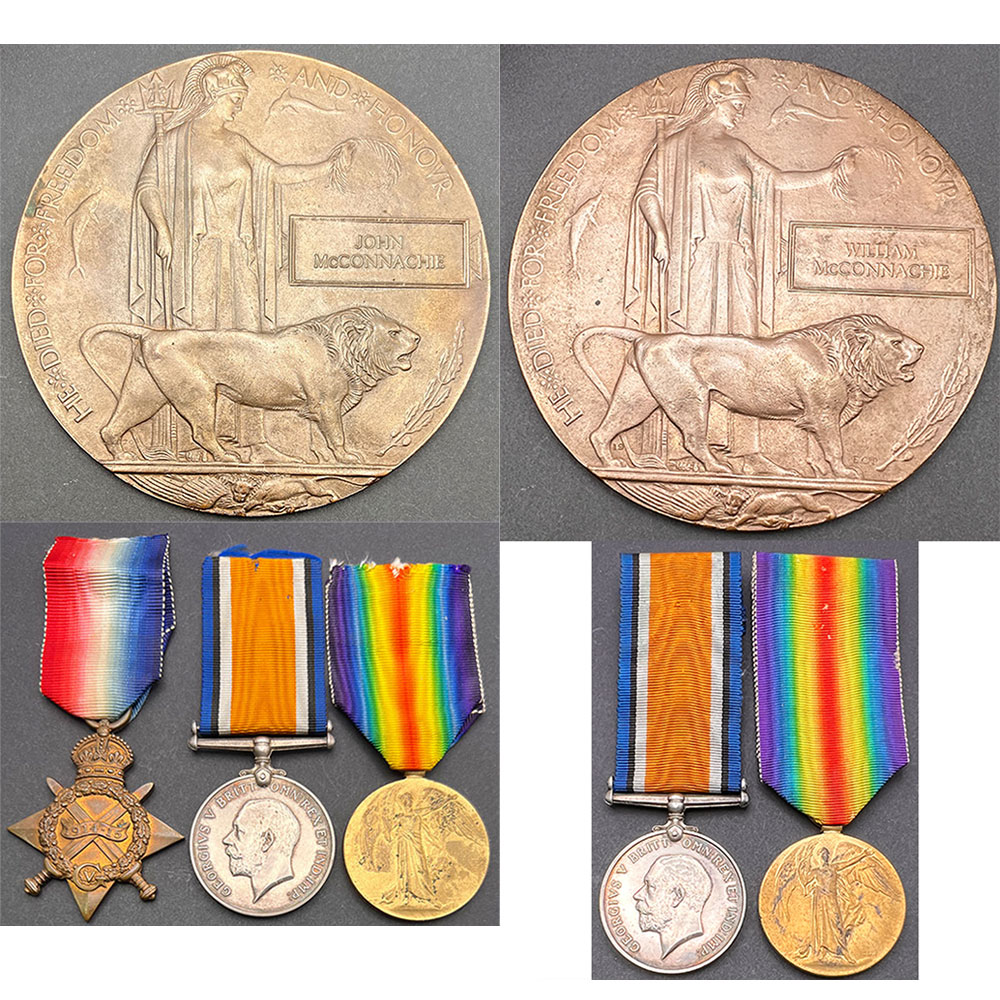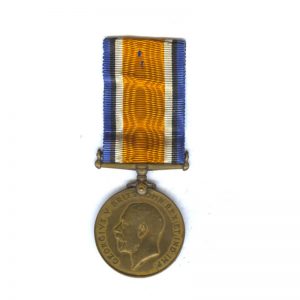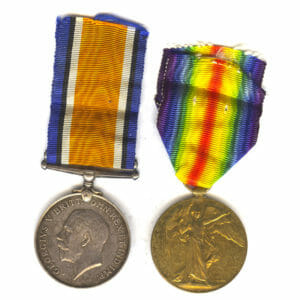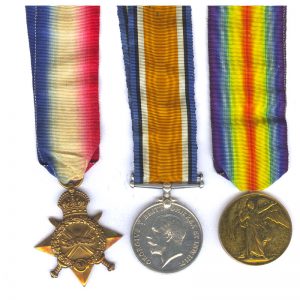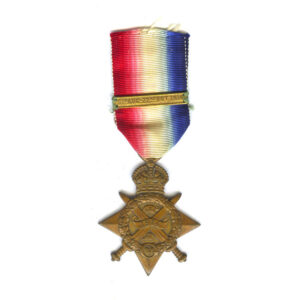Description
2 Casualty Memorial Plaque Groups to the McConachie Brothers of Huntly, Aberdeenshire. One died of wounds as a POW in Germany, the other was killed in action.
Brother 1, Lance Corporal John McConnachie, “D” Company, 6th Battalion Gordon Highlanders.
1914-15 Star, British War and Victory Medal, Memorial Plaque
1914-15 Star officially impressed: “12304 CPL J. MC CONNACHIE. GORD. HIGHRS.”
WW1 Pair officially impressed: “12304 Pte. J. McConnachie. Gordons.”
Memorial Plaque embossed: “JOHN MCCONNACHIE”
John died of wounds as a German Prisoner of War, having been captured at Arras when wound in action in the leg on 23rd April 1917.
The War Diary records him on a long list of men from the Battalion who were left as “Unaccounted For” after the battle on 23rd April 1917.
He was registed as taken by the Germans on 24th April 1917 and was then taken back to Germany.
Not long afterwards after reaching Germany he died of his wounds in captivity on 10th June 1917.
He was buried by them in the Niederzwehren Cemetery in Kassel, Hessen, which was made for Allied POWs who died in captivity in the local POW camp.
During April 1917, the 6th Bn Gordon Highlanders lost half their number as Battle Casualties.
They came into April with 41 Officers and 970 Other Ranks.
Receiving Battle Casualties to the number of 19 Officers and 494 men, with another 16 evacuated as sick.
During the time that he was captured, a large offensive was waged by this unit from 22-24th April.
“The work assigned to the 6th Gordon Highlanders was the capture of the German Trench (Known as the RED line), the capture of hausa and Delbar Woods and establishing posts on outer flank, and the digging of a support line 200 yards on the British Side of the German trench.”
THE ATTACK
“At zero plus 1 hour (5:45 a.m.), the 6th Gorcon Highlanders left the assembly trenches in an artillery formation with four lines of half platoons in file. Lieutenant Colonel Dawson, D.S.O., led the first two lines, consisting of “A” Company (on the right) and “B” Company (on the left). “C” and “D” Companies formed the second two lines. The enemy’s artillery barrage was heavy, but the battalion did not suffer greatly, except in one case where a platoon of “B” Company was almost wiped out. It had been expected that extension would not be needed until the battalion had passed the CHEMICAL WORKS, but long before this position was reached, heavy machine gun fire made extension necessary, and the companies were extended at approximately H.18.8. and C.
The companies had to advance after this mainly through communication trenches. Around 6 a.m., Lieutenant Colonel J. Dawson was severely wounded, and command devolved on Captain J. Hutcheson. Under his command, the advance continued for some distance, but this was only possible with the assistance of a tank, which came in response to a signal and cleared the first German trench (BLACK LINE). Captain J. Hutcheson advanced as far as the CHEMICAL WORKS, establishing his headquarters at I.18.0.9., and posts were set up around the CHEMICAL WORKS. This was completed around 8:30 a.m. Urgent messages were sent for reinforcements, but none arrived. As it was considered that the numbers in and around the CHEMICAL WORKS were too few to hold back an imminent counterattack, Captain J. Hutcheson decided to withdraw to the old British lines. This withdrawal took place around 12 noon, but a strong post was left at Quarry, which later in the evening, at 8:30 p.m., When another British advance took place, this post, which had held its ground all the time, took part in the advance.
Around 11:45 p.m., the battalion was withdrawn to the British front line and remained there throughout the night. At 12 noon the following day, the battalion was relieved by the 25th Northumberland Fusiliers (103rd Brigade). After resting for some time in the support trenches, they were withdrawn to bivouac in ST NICHOLAS.”
The end of the battle, in defeat:
“From the foregoing it will be seen that the objectives were not gained, this failure was due to the fact that the BLACK and BLUE lines were not taken, but had to be fought for, and the time taken to do this lost to the attack the protection of our own artillery barrage.
The enemy machine gun fire was of an extremely galling nature. The Battle went into the Battle 630 Strong, Total casualties, 21 killed, 5 died of wounds, 184 wounded, 28 missing in action (including McConnachie), totalling 241 of their 630.
Brother 2, William McConnachie, 14th Fife and Forfar Yeomanry Battalion, Black Watch (Royal Highlanders), formerly of the Scottish Horse.
William went missing and was killed in action on 10th September 1918, aged 20.
British War and Victory Medal, Memorial Plaque.
Full entitlement of medals.
BWM & Victory officially impressed: “S-41665 Pte W. Mc Connachie. R. Highrs.”
